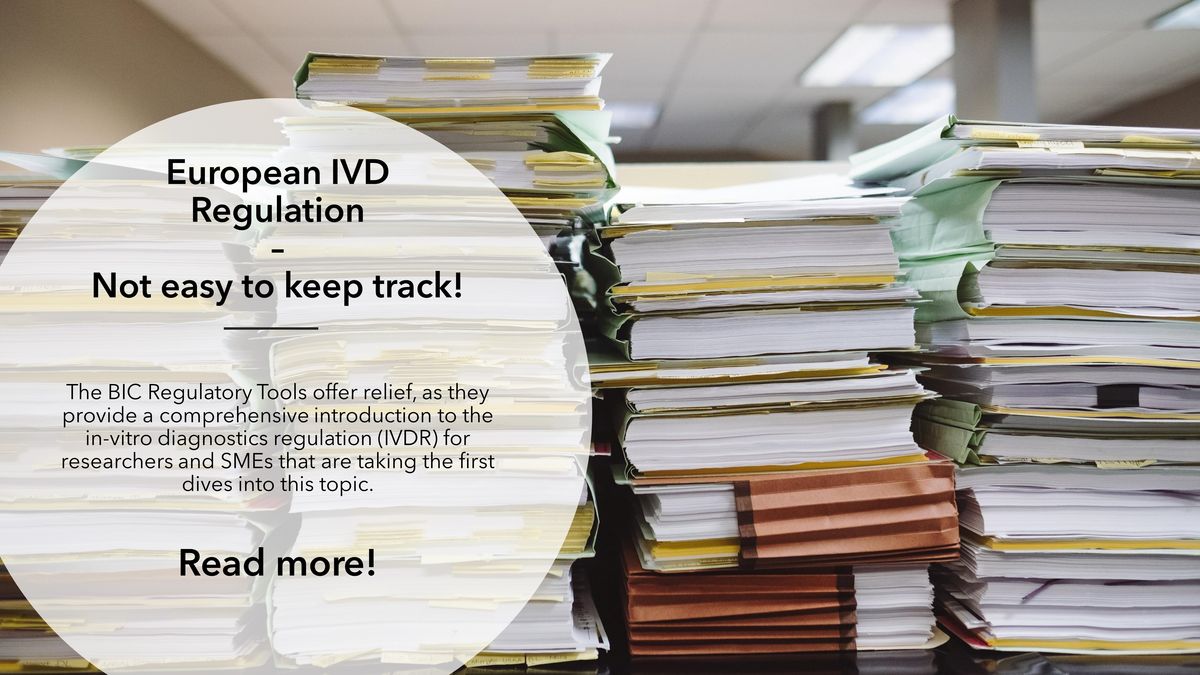
News

Here, the BIC Regulatory Tools offer a relief, as they provide a comprehensive introduction to the in-vitro diagnostics regulation (IVDR) for researchers and SMEs that are taking the first dives into this topic.
“Hopefully, these tools will encourage researchers to consider commercialization of their discoveries and improve the understanding of the regulatory process within the academic community”, tells Valerie Daussin from The University Hospital of Aalborg in Denmark, project leader for the consortium.
BIC In-Vitro Diagnostics Regulatory Tools: IVDR Guide and IVDR Roadmap
The BIC Regulatory Toolset consists of two separate, yet complementary tools: the IVDR Guide and the IVDR Roadmap. The IVDR Guide is written from the scientific perspective and tells what is required during the commercialization process, focusing on the so-called TTO Commercialization Model. This model forecasts close collaboration between the researcher and the technology transfer office (TTO), to achieve an efficient technology transfer to industry. TTOs serve as a catalyst for commercialization processes and assist in the comprehensive project evaluation. Proper cooperation with TTOs should lead to an investor or industrial partner engagement, or a company launch (e.g. spin-out).
“The IVDR Guide is like a cookbook for early-stage biomarker inventions and includes core elements of the commercialization process”, explains Pawel Myszczyński, the main author of the BIC Regulatory Tools and a R&D Project Specialist at Wroclaw Technology Park in Poland.
The IVDR Roadmap is more focused on later stages of the development and is written from the manufacturer’s perspective. It is a map that provides guidance not only on what to do, but also on how to do it. The flowchart is available in a user-friendly digital format. It provides a compressed overview of the process, and at the same time it is possible to zoom in for more details.
“The manufacturer is faced with a set of regulations and standards around the IVDs. In the IVDR Roadmap, the regulatory activities are aligned with the standards that provide the solution to achieving regulatory compliance,” continues Pawel Myszczyński.
The BIC IVDR toolset and other BIC tools were presented at the online event The European In-Vitro Diagnostics Regulation. The material and the recording of the event are available here: https://biomarker.nu/news/tips-and-tools-for-dealing-with-the-ivdr
The BIC Regulatory Tools were developed by the BIC BRIDGE Consortium along with other tools to ease the biomarker commercialization process. The IVDR Guide is available on the BIC Commercialization Tools webpage and the IVDR Roadmap will become available on the same webpage this summer: https://biomarker.nu/ivdr-guide.
Follow us on LinkedIn for the latest updates: https://www.linkedin.com/company/37803411
About the BIC BRIDGE Consortium
BIC BRIDGE is based on the project main outputs and results from BiC – Biomarker Commercialization and serves not only to improve the outputs delivered in the original project but also to a whole new set of activities aiming at increasing the scope of the tools and broadening the target groups, as well as increasing usability, sustainability and impact. The consortium comprises 9 partners from the Baltic Sea Region (BSR) and beyond. It consists of innovation units localized in research institutions, cluster organisations, SMEs and European Research Infrastructure Consortium within the health diagnostic, pharma and med tech field. The extension stage project is running for 9 months. The project’s budget is EUR 0.76 million and is co-financed by the European Regional Development Fund through the Interreg Baltic Sea Region Programme with EUR 0.58 million. Read more: biomarker.nu